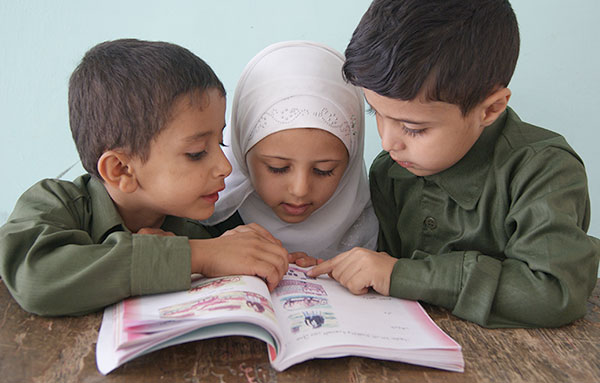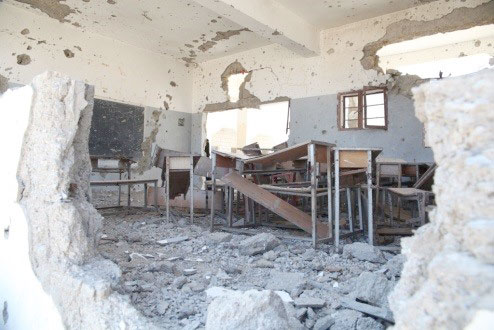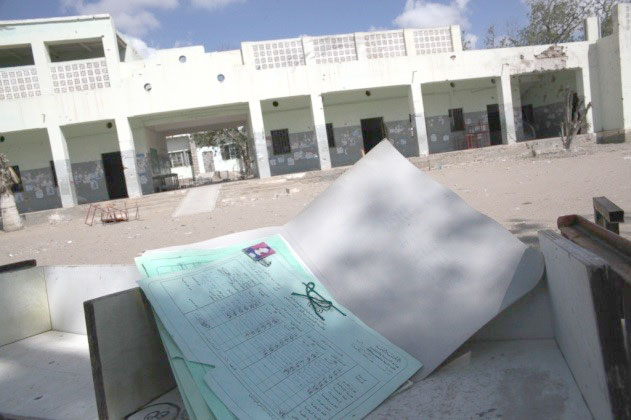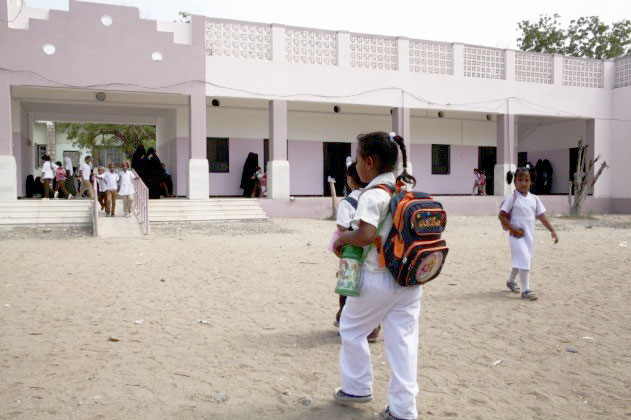
Pour l'arabe, cliquez ici.
.Pour lire l'article en arabe, cliquez sur ici
Jusqu'en mars 2015, quand le conflit s'est intensifié, 1.3 millions d'abord, les élèves de deuxième et troisième années apprenaient à lire en arabe dans tout le Yémen, même dans le au milieu d'un conflit.
Avec le soutien des États-Unis. Agence pour le développement international et autres donateurs internationaux, le ministère de l'Éducation étendait une nouvelle réforme de l'éducation nationale qui comprenait le projet de lecture en première année. Creative Associates International a fourni un soutien technique et de mise en œuvre sur le terrain depuis 2010.
Avec l’escalade du conflit au Yémen fin mars, presque toutes les activités éducatives sont au point mort. Le Coordonnateur humanitaire des Nations Unies pour le Yémen, Johannes Van Der Klaauw, estimé que 2 millions d'enfants n'ont pas pu aller à l'école.
Malheureusement, le conflit a causé d'énormes pertes, y compris la vie des enfants. Certaines écoles ont été détruites, alors que la plupart des universités et écoles ont fermé par souci de sécurité.
L’éducation favorise la stabilisation
L'éducation en temps de conflit joue un rôle essentiel dans la reconstruction des communautés touchées par la crise, créer un sentiment de stabilité et préparer les résidents à un avenir paisible. Des écoles sûres créent un environnement protecteur pour l’apprentissage et la guérison.
Les niveaux nationaux d’éducation supérieurs sont corrélé avec moins de risques de conflit armé. Une éducation de qualité et sensible aux conflits peut contribuer à stabiliser les sociétés et à améliorer le bien-être économique et social..
TOUJOURS "Rapport du Secrétaire général sur la consolidation de la paix au lendemain d'un conflit», constate que « dans les situations de conflit, l'éducation est plus qu'une simple prestation de services et constitue un moyen de socialisation et de développement identitaire à travers la transmission des connaissances, compétences, valeurs et attitudes à travers les générations.
Ainsi, tandis que l’éducation peut être un moteur potentiel de conflit si elle est cooptée (alimenter les griefs, stéréotypes et xénophobie), elle peut également contribuer à la transformation des conflits et à la consolidation de la paix lorsqu’elle est mise en œuvre de manière inclusive et sensible aux conflits..
Les donateurs devraient non seulement poursuivre et intensifier leur soutien à l’éducation pendant la crise actuelle au Yémen, mais aussi se préparer au développement de l’éducation après le conflit..
Robuste & aide stratégique à l'éducation

La reprise de l’aide internationale pour le développement de l’éducation au Yémen, surtout au Yémen post-conflit, devra être stratégique et robuste.
Dans les premières étapes, Les infrastructures des écoles et du ministère de l'Éducation auront besoin d'être réhabilitées suite aux dommages et à la destruction des écoles pendant le conflit.. Les enfants et les familles déplacés peuvent avoir besoin d'accéder aux écoles communautaires d'accueil, des espaces adaptés aux enfants ou d'autres centres d'apprentissage temporaires.
L'éducation peut jouer un rôle protecteur. La recherche et la pratique montrent que les écoles, les environnements d’apprentissage et les éducateurs peuvent contribuer au bien-être et au développement sain des enfants. L’aide doit permettre aux programmes éducatifs d’être participatifs, favorable, enfant- et adapté aux jeunes, et libre d'humiliation et d'abus.
Intégré, soutien scolaire aux groupes vulnérables, comme les enfants associés aux forces combattantes et aux groupes armés, sera nécessaire. Le soutien psychosocial des éducateurs réduit également le stress et l’anxiété liés aux conflits.
Les enfants non scolarisés auront besoin de programmes de « rattrapage » pour terminer leurs études ou rattraper le temps perdu.. Réhabilitation scolaire, avec un rôle important pour les parents et les membres de la communauté, contribuera à restaurer un sentiment d’espoir et de normalité et à créer des environnements d’apprentissage sécurisés. Maintenir le fonctionnement des écoles au Yémen peut également aider les communautés à comprendre les causes sous-jacentes du conflit et à renforcer les messages anti-violence..
Le Yémen se situe au bas du classement du monde arabe pour un certain nombre de mesures liées à l'éducation, selon la Brookings Institution Baromètre de l’apprentissage dans le monde arabe. Les gains d’apprentissage des étudiants au Yémen sont les plus faibles parmi tous les États arabes avec 91 pourcentage d’élèves du primaire n’atteignant pas les niveaux d’apprentissage de base. L'abandon scolaire parmi les élèves du primaire yéménites a diminué au cours des dernières années. 10 années, mais reste le plus élevé du monde arabe.

Les besoins éducatifs du Yémen avant le récent conflit étaient nombreux. Le ministère de l'Éducation, avec le soutien de donateurs internationaux, a eu des projets ambitieux, y compris l'augmentation du nombre de salles de classe et la réduction des doubles vacations; accroître le pourcentage et la qualité des enseignantes; augmenter les inscriptions d'étudiants, surtout pour les filles; et réformer la lecture et les mathématiques dès les premières années d'études jusqu'à la cinquième année.
Le ministère de l’Éducation aura besoin d’une aide solide et à long terme pour atteindre ses objectifs, qui peut inclure des mesures visant à résoudre les problèmes découlant du conflit (c'est à dire. réforme des programmes scolaires et décentralisation).
Dans un Yémen post-conflit, avec du nouveau personnel en place, le ministère de l'Éducation aura également besoin d'un soutien pour renforcer ses capacités et renforcer ses systèmes.. Pour concrétiser ces projets, il faudra des efforts considérables, des efforts stratégiques et soutenus pour maintenir les progrès réalisés en lecture et dans d’autres domaines, et rétablir le système éducatif.
Un modèle d’éducation pendant et après les conflits
Le systémique, approche transparente et inclusive de la réforme de la lecture dans le cadre Approche de lecture en début de année au Yémen a non seulement renforcé l'alphabétisation et le système éducatif national, mais a également accru la stabilité et la sécurité des étudiants, familles et communautés. Ce programme peut servir de modèle pour mettre en œuvre des programmes d'éducation de qualité en pleine guerre et pour reconstruire le Yémen après le conflit..
La réforme nationale de la lecture menée par le ministère du Yémen a constitué une force unificatrice essentielle avant le récent conflit.. Un soutien continu à cette réforme éducative et à des réformes similaires après le conflit a le potentiel de faire progresser le pays vers la paix..
Grâce au programme, parents, les membres de la communauté et les responsables de l'éducation se sont réunis pour travailler à la réalisation des objectifs communs d'amélioration de l'alphabétisation., prévenir le décrochage scolaire et donner aux enfants les bases éducatives dont ils ont besoin pour progresser économiquement.
Le programme a contribué à bâtir des relations plus solides entre les parents, enseignants et enfants. Les parents consacrent plus de temps à la lecture à la maison avec leurs enfants et interagissent plus étroitement avec les enseignants pour stimuler la lecture de leurs enfants..
Partager ces objectifs communs et travailler à leur réalisation, même au milieu d'un conflit, a jeté les bases de communautés et d’écoles fortes qui seront essentielles à la stabilisation post-conflit.
Le programme a également mis l'accent sur la parité entre les sexes dans les classes parmi les élèves et les enseignants : il y a plus d'enseignantes que d'hommes dans les premières années du primaire.. Des recherches montrent que lorsque les filles terminent leurs études secondaires, les taux de fécondité diminuent., le mariage des enfants diminue, des indicateurs socio-économiques solides augmentent et les communautés deviennent plus résistantes à la violence.
Aujourd'hui, De mémoire récente, les enfants yéménites des écoles primaires ont sans doute les meilleures chances de rester à l'école., réussir ses études et terminer ses études secondaires – l’un des meilleurs prédicteurs de réduire le risque de conflit.
Ainsi, maintenir l’attention et poursuivre la mise en œuvre de ces acquis en matière d’éducation au Yémen, devrait guider notre réponse actuelle et future en matière d’éducation.
Les enfants ne peuvent pas attendre

Aujourd'hui, des milliers d'élèves de première année au Yémen n'ont terminé que six mois de scolarité en raison du conflit. Que va-t-il leur arriver?
Les sociétés qui ne sont pas en mesure de poursuivre leurs programmes d'éducation en raison d'un conflit courent un plus grand risque de se retrouver piégées dans un cercle vicieux où l'éducation est constamment interrompue par la guerre.. Cela augmente à son tour le risque de conflit armé à l’avenir.. Les jeunes passent à côté de précieuses années d’éducation.
Nous appelons tous les acteurs – USAID, le Partenariat mondial pour l'éducation, la Banque mondiale, UNICEF, UNESCO, la Société allemande de coopération internationale (GIZ), Agence japonaise de coopération internationale, le ministère des Affaires étrangères du Canada, Commerce et développement, Le ministère australien des Affaires étrangères et du Commerce et les donateurs européens s’unissent dès maintenant pour répondre aux besoins éducatifs actuels du Yémen et préparer les bases d’un système éducatif robuste après le conflit..
Le secrétaire général de l'ONU a nommé l'ancien Premier ministre britannique Gordon Brown Envoyé spécial de l'ONU pour l'éducation mondiale afin d'aider à galvaniser le soutien à L’éducation d’abord. L'initiative rassemble un large éventail de dirigeants et de défenseurs qui s'efforcent d'utiliser le pouvoir transformateur de l'éducation pour construire un avenir meilleur pour tous, pendant et après les conflits..
Objectif de la stratégie éducative de l’USAID 3 cherche à accroître l’accès équitable à l’éducation en période de crise et de conflit pour 15 millions d'apprenants. Beaucoup de ces apprenants résident aujourd’hui au Yémen.
Alors que les acteurs et la configuration de l’État yéménite post-conflit ne sont pas encore en place et ne seront peut-être pas clairs avant longtemps, une stabilité accrue dans un avenir proche offrira des opportunités de maintenir la dynamique des réformes en matière de lecture dans les premières années d'études, fournir des environnements d’apprentissage sécurisés et entamer le processus de soutien à long terme pour l’inclusion, une éducation représentative et de qualité qui contribuera à briser le cycle du conflit au Yémen.
Les enfants ne peuvent pas attendre.